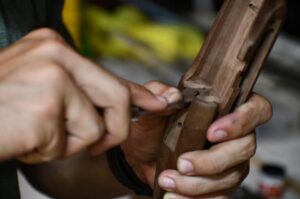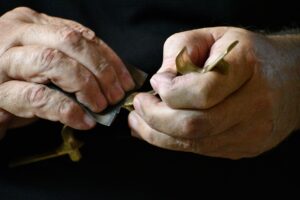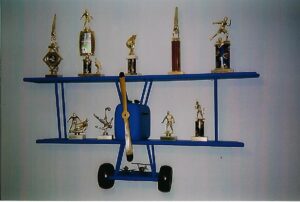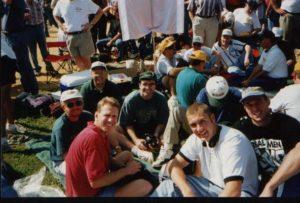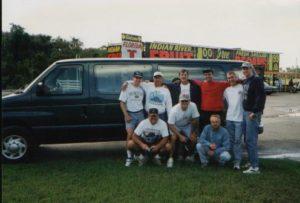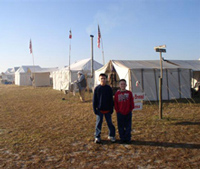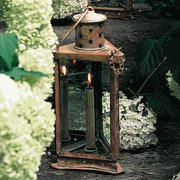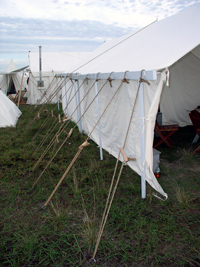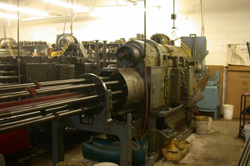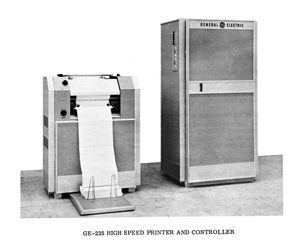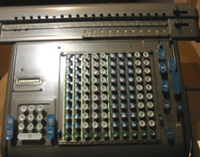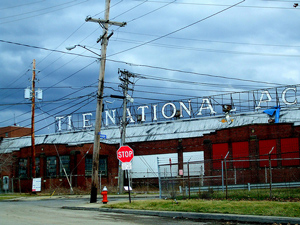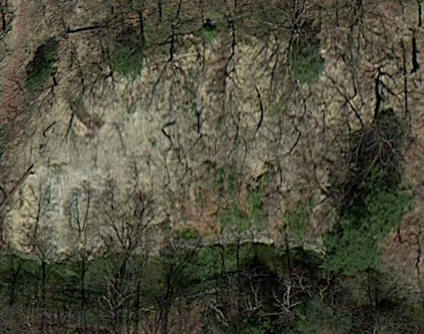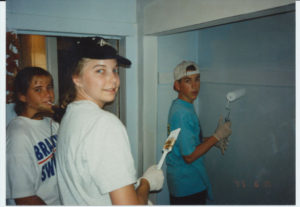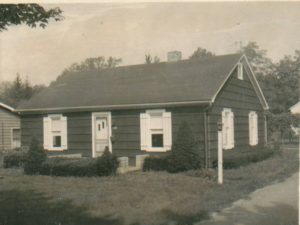Foreword
This is a time when American history is under attack. Schools selectively remove our history based on the current winds and whims brought on by a culture apologetic for America. Through thousands of dedicated hours, I have taken time to share my limited knowledge of history with children and felt it was time to share my story. Numerous times, too many times to remember, I dressed in period clothing to seek out events where I could share my own love for American history. These are called living history events for a reason. The goal for me was to bring history alive—to not only remind us of our past but to share what our nation has learned through those early formative years and then give my listeners a few lasting memories.
The Challenge
David Barton is a New York Times best-selling author. From his writings, he taught me that the world is quite creative in its destruction of America’s history. He lists seven strategies that are being used to re-program our youth against America. My goals are to avoid all of them.
Historical Negativism – An accurate presentation of history depends on the telling of the good with the bad, an honest, balanced presentation of events, people, or time periods. Our history is not all bad!
Relativism – This asserts that in history, religion, culture, and law are not absolute. Values are to be determined individually, and personal standards trump traditional ones, thus allowing subjectivity and feelings to prevail over objectivity. This attitude would claim that our Constitution is old and out of date. Nothing could be farther from the truth!
Anti-nationalism – This is the constant undermining of patriotism, or the love of one’s country. Remember, we are the only country on earth that people risk their lives to get into. People are free to leave, yet few ever do!
Rejection of American Exceptionalism – This rejects the idea that America is blessed and enjoys unprecedented stability, prosperity, and liberty because of unique ideas such as God-given inalienable rights, individualism, limited government, and an educated, virtuous citizenry. I am still waiting to find a history book somewhere better than America!
Modernism – This is the malpractice of examining historical events and people as if they occurred and lived today rather than in the past. Modernists destroy monuments, deface historical sites, and protest everything good. Lose the past, and you will lose your purpose!
Minimalism – The unreasonable insistence on oversimplification, on reducing all things to political rhetoric and one-line slogans, forgetting the complexities of history. Open and honest dialogue requires time for “both” sides to discuss their concerns after they first understand each other’s!
Rigid Secularism – The constant misrepresentation of the influences of religion in American history Our history has recognized that all must have freedom of religion, not freedom from religion. Faith, the belief in a Creator, exists in every culture on earth. Who planted that belief in the hearts of men? World history tells us over and over that America is unique – believe it or not, what you believe in is totally up to you. Choose carefully!
Why Bother
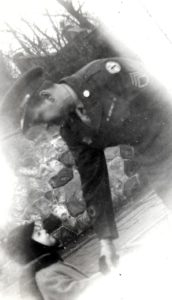
Meeting my father at 3 years old for the 1st time as he returns from WWII
My family heritage has no doubt been the driver of my beliefs. I have no family that fought in the Revolution or Civil War. All four of my grandparents came through Ellis Island along with my mother. Being of Lithuanian descent, I grew up with stories of all three invasions of Lithuania by the Russians. One of my grandfathers was conscripted into the Russian Imperial Cavalry and had to escape his country, coming to America to gain freedom. His term of service was to be 20 years. My father was drafted within weeks of my birth, and with his brothers, we all fought in World War II. Within our immediate family, my father’s sister married a wonderful Lithuanian man named Alex. He bore the serial numbers of a German Concentration Camp on his arm. I have heard the stories hundreds of times about how their freedom was taken away from them—not once, but multiple times. When you grow up with family members banished to Siberia, or worse, murdered because of their religious beliefs, your own beliefs become embedded into the bedrock of why America and its Constitution are so important.
No generation can survive without a knowledge of history. Not only are they doomed to make the same mistakes, but they shelter themselves from the very proof that there is a Creator and He does have a plan. The present turmoil in our world has been there since its creation and will not disappear soon. Adults have a responsibility to make sure we equip our children and grandchildren with the tools to survive. That is the very purpose behind my efforts called “Patriot Camp.” What is in such a camp? Well, time to share my goals and story with future generations. Please consider carrying the torch of liberty and keeping it lit for our children to see.
How to Tell a Story
With the above introduction as a background, I chose, as my period of history, our country’s founding. As I worked with schools, churches, and at public events, I often found the area most often misunderstood was the meaning of a constitutional republic. To most children, history was just a list of confusing dates and places. Adults call these “events,” and rarely did the children I met ever garner experiences and understanding for their lives from them. Something was missing. My goals began to shift from “timeline” teaching to “cause and effect.” Much like the examples of using parables in the New Testament, I began to use history and its many stories to pass on knowledge that would be beneficial today. The best stories leave the human mind to ponder a bit and teach about life and why we are free today. This took more time, but it was necessary if I were to take a simple date and event and translate it into life-altering learnings. Let me give you an example.
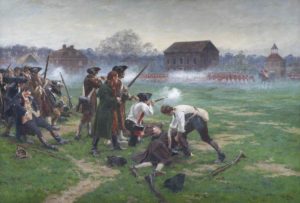
Wollen, William Barns; Battle of Lexington, 19 April 1775; National Army Museum; http://www.artuk.org/artworks/battle-of-lexington-19-april-1775-183073
The Patriot Day’s story (April 19, 1775) started the night before when two lanterns were hung in the Old North Church. There was a famous ride by Paul Revere. Did you know that Revere never actually arrived in time to warn the patriots? So who warned them? The story involves answering the question, Why were the British even going to Concord, MA? Once pieces like these are put in place, a vivid picture can be brought forth. You can start to see some of the building blocks that went into our Declaration, Constitution, and Bill of Rights. There is an element of religious freedom in the Old North Church story, even some historical controversy. The event is intertwined by the trust between two lifelong friends who grew up singing in the choir together, a friendship that helped launch the creation of America. There was intrigue and sacrifice, and that was all before a single shot was fired in Lexington.
Stored in Concord were the “military weapons,” the 1775 version of today’s assault rifles, the Brown Bess. To understand the meaning of the 2nd Amendment, one must understand what was at risk if the British had been successful that day. There were also individual stories of ordinary men, ready to give their lives for freedom. Oh yes, and there were the first shots fired. Do you know the names of the first nine people to die? They were farmers and shopkeepers, ordinary people, called Minute Men. Just that simple date has often taken me hours to explain. While I told my stories, I always let the children hold pieces of history, lots of show and tell. A flintlock rifle, a powder horn, or maybe a real Tri-Corn hat. In the end, they would have been introduced to some new people, like John Pulling and his wife Sara (if you do not know of them, you should). My goal in that one date was for the children to understand what happened, why it happened, and the benefits that they now have because that day happened the way it did. With this example now behind us, let’s look at how I tell my story.
Setting the Stage
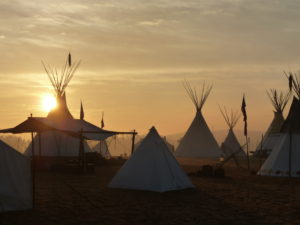
The Iroquois Confederation
I always like to start with where human rights and the desire to be free come from. Two examples are worthy of review: The Magna Carta and the Hiawatha Wampum (also called the Great Law of Peace). Both will take us back in time to the 1400’s. The Magna Carta was the first time a king ever wrote down his promises to the people. Until then, the people were fully subservient to the kings. King John did not honor his 63 promises, but it set the stage for the future idea that leaders serve the people, not the other way around. It is nice to have a copy of the Magna Carta for the children to see.
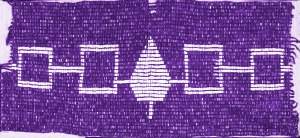
The Hiawatha Wampum
The second example comes from the Confederation of the Iroquois. In the 1400s, there was a five-tribe confederacy here in North America that wrote a constitution using wampum beads. Hiawatha was a pre-colonial Native American leader and co-founder of the Iroquois Confederacy. Depending on the version of the narrative, he was a leader of the Onondaga, the Mohawk, or both. This was so advanced for the time that when Ben Franklin and others were getting around to creating America’s Constitution, they incorporated many of its ideas. Think about that: our native citizens were co-authors of our own Constitution. The concept of writing history takes many forms. This one comes from quahog shell beads. Our national logo of the eagle holding 13 arrows in its left talons and an olive branch in its right is rumored to have come from Hiawatha. To convince the five separate tribes that they would be stronger if united, there is a story that he broke a single arrow and then grasped five and showed they could not be easily broken. Unity provided strength and peace.
The French and Indian War
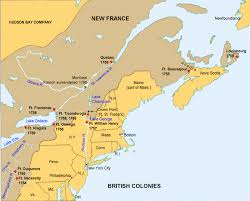
Map of the French and Indian War
Most talks I do begin with the French and Indian War. It is not that I do not like the Pilgrims or the early settlers, but most of their story begins in England. My history starts right here in America with a war called the Seven Years’ War. It was a global conflict that was fought between 1756 and 1763. It involved all five European great powers of the time—the Kingdoms of Great Britain, Prussia, and France, the Habsburg Monarchy of Austria, and the Russian Empire—plus many of Europe’s middle powers and spanned five continents, affecting Europe, the Americas, West Africa, India, and the Philippines. Here in America, the French and Indian War (1754–1763) was just a part of the Seven Years War. It pitted the colonies of British America against those of New France, each side supported by military units from the parent country and by American Indian allies. At the start of the war, the French colonies had a population of roughly 60,000 settlers, compared with 2 million in the British colonies.
I picked this starting point because of an interesting decision made by King George II. In America, the colonists saw this war as an opportunity to expand westward and defeat the French. The colonists wanted to raise their army and drive the French out of the land west of the colonies. Remember, the colonists were British subjects, loyal to their king. King George II was concerned, however, that if he let the colonists develop an army, someday that army could be used to break away from Britain. The King wanted British troops to do all the fighting. Later in history, we would see that the king’s instincts were right on the mark. While I am versed in speaking on this war on topics such as George Washington’s early contributions at Fort Necessity and the religious aspects of this war, I generally do not include this material. It was a barbaric war, and I find it hard to share much about what we may have learned. I often wonder if we learned anything by our experiences in the French and Indian War. But I started here because of the debt Britain created fighting the war. Teaching children about debt is one of my paramount goals. You will see this later.
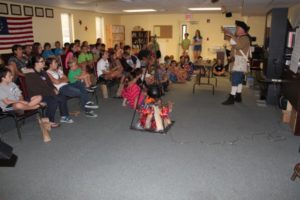
A Patriot Camp discussing life in the 18th century
After the introduction of this war, I prefer to shift to colonial life. What was the frontier like during these times? What were the hardships? What would it have been like to be a child living in the 18th century? What was school like? What did people eat? Did children have toys? Most children have never thought about any of these things. I use this time to talk about candles, lanterns, their water coming from a well or stream, chopping wood, and cooking over a fire. I try to show them how to start a fire with flint and steel, how heavy a pail of water is, what a campfire looks like, cast iron pots and pans, and simple things like dishes and cups. Ever eat with a two-pronged fork? Our ancestors did. We talk about clothes, transportation, shoes, hats, and other things that most of us never think about. It usually is a fun time with lots of show and tell. My travels have provided me with opportunities to acquire many accoutrements that are “touchable.”
My wrap-up on this war is to emphasize that by the end of the French and Indian War, by 1763, Britain was in debt. The British thought the colonists should help pay for the cost since the war was of benefit to the colonies and for their protection. The war had cost the British treasury £70,000,000 and doubled their national debt to £140,000,000. In today’s US currency, Britain’s national debt is equivalent to over 5 billion dollars. It does not sound like much in today’s dollars, but you need to consider that it was about 15 times their GDP. This is a great place to introduce interest, inflation, and GDP in a form that children can understand.
There is a simple lesson to this segment: too much debt is not good, and debt must always be paid back. This debt was about to generate oppressive government taxes and policies against the colonies and set the stage for the American Revolution. Depending upon the age of the students, this opens an opportunity to discuss the National Debt of America, currently around 1.3 times GDP. Yes, life was hard, life was dangerous, and life was simple! The story is really about a family with an out-of-control credit card. These are good stories to help ground children in the meaning of indebtedness.
Taxes and Tea
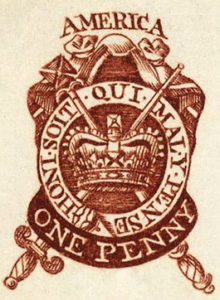
Tax Stamp
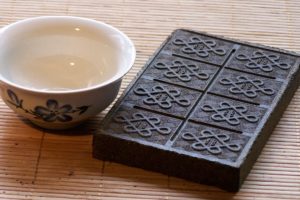
Brick of Tea
Next comes the concept of currency and taxes. I can cover them all. Immediately after the end of the French and Indian War came the Money Act of 1764. It simply took all the power to set value and to set import and export pricing and placed it in the hands of Britain. We talk about paper money, gold and silver, barter, and trade. They get to see samples of colonial-printed money and coins. It is also important for children to understand that taxes only work if they are applied to things you want and purchase. Some of the first taxes were on sugar, so I brought out my brown cone sugar and sugar nippers to let them taste. It is dried molasses (sugar). We talk about the Stamp Act, and I bring out my deck of playing cards with a tax stamp on them. We cover the Boston Tea Party, and they get to hold a brick of tea; no tea bags here. There is a long list of taxes to choose from. The purpose is to provide them with sufficient context so they understand the grievances stated in the Declaration of Independence.
Depending on time, we talk about how their family might be impacted by some of King George III’s repeated harm to Americans’ rights and liberties. As people’s taxes went up and they complained, more and more rights were taken away. The policies of control administered by King George III were oppressive. Regulations can be good, but they can also remove freedoms. It is good to talk about all of this. When the Declaration was finally written, it was about real hardships imposed by a tyrannical king. Some of the areas I try to cover are:
- Quartering of armed troops
- For cutting off trade with all parts of the world and the impact of the East India Company on the economy, basically price fixing and single-source monopolies
- For imposing Taxes without our Consent or representation
- For depriving many of the benefit of Trial by Jury
- Judicial independence
- And much more when time permits.
The opening of history should be to build a bridge to the importance of personal rights. Remember, Great Britain wanted money to pay their debts—a lot of money. Here is where the story usually takes the turn of describing our society today and the benefits of the rights being taken away from the colonists. The goal is to make sure that everyone listening has a sense of why the colonists were angry—angry enough to go to war and even risk their lives. There are a few other special stories I might tell in this part.

Paul Revere’s engraving of the Boston Massacre
One of my favorites is the engraving by Paul Revere of the Boston Massacre. I use this story because it was a fraud, fake news. The engraving did not represent what happened that day. I have stood on the very spot where the massacre took place; I can even show you a spot in the engraving where a man is firing a gun out of a second-story window. This did not happen that day but represented the first death attributed to the British occupation of Boston. On February 22, 1770, 11-year-old Christopher Seider became the first casualty of the American Revolution. Revere made sure to stir up that old anger from an event that had occurred earlier. That engraving circulated throughout the colonies and helped fuel the emotional anger building against the British.
After the Boston Massacre, John Adams, a Founding Father, the first vice president of the United States, and the second president, would defend the British soldiers in an “all colonial’ court as their defense lawyer and win their acquittal. The Revere picture was just propaganda, meant to awaken the people. I tell the story not to demean Paul Revere but to let children know that they will have a responsibility in life to always search for the truth. It is not on Facebook or Twitter. Truth requires perseverance and an open mind. Our world is not always honest.
My Favorite Part of the American Story
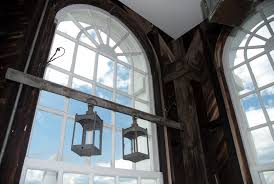
Old North Church Steeple: Two if by Sea
In 1775, on the eve of America’s Revolution, the majority of the congregation of the Old North Church were loyal to the British King, and many held official positions in the royal government, including the Royal Governor of Massachusetts, making the fact that some members were loyal to the Patriot cause even more extraordinary. Into history comes Paul Revere, a talented silversmith and engraver, but more importantly, now an active member of Boston’s Sons of Liberty. For months, he served as the group’s messenger, carrying information as far away as Philadelphia. The Royal Government (the British government in Massachusetts) wanted to ensure that troops would be able to secure the colony in case of rebellion. Orders went out to confiscate weapons that the Colonists had been storing throughout the countryside. The weapons were cannon, black powder, and Brown Bess Muskets. The muskets were not for hunting. They loaded twice as fast as hunting rifles, were 75 caliber in size, and could carry a bayonet. This made them a 7-foot-long spear in battle. They were assault weapons that would be necessary to fight the British.
Several parties of British troops had been sent up the coast to confiscate ammunition in Salem and parts of what is now New Hampshire. In both of those cases, Paul Revere and other riders who were members of the Sons of Liberty alerted the townspeople of the movement of British troops well before those troops could reach their destinations. The munitions were successfully hidden, and the British troops were humiliated.
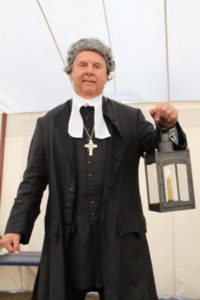
Myself at a living history event holding a replica of one of the lanterns hung in the Old North Church Steeple
British soldiers guarded the exits to Boston, and anyone caught wandering the streets after dark could be arrested. Paul Revere and a friend, William Dawes, were to ride and warn the men in Lexington and Concord once they knew the route of the British troops. If either man were detained, their warning would not reach the minutemen. A backup plan was needed. Revere recalls the view of Charlestown from atop the Old North Church where he rang the bells as a teenager. He approached an intimate friend from boyhood and a business associate, Captain John Pulling, to help. Both Paul Revere and John Pulling were members of Boston’s Committee of Correspondence. One of the principal roles of its members was to gather intelligence and track the movements of British troops within the colonies. Pulling also still had ties to the church, and Revere would ask a huge favor—to hang signal lanterns in the steeple. This would be my opportunity to explain to children the power of a single candle. Did you know that it can be seen for up to 30 miles at night? At this point, I show the children my replica of one of those lanterns. They get to hold in and relive that night on the steeple. Most children today do not even know what a steeple is.
John Pulling was the perfect choice. He was not only a member of the church but also a vestryman (part of the church’s governing body, like an elder). John Pulling was a passionate patriot. We know this because earlier that day, the church leaders, Pulling and other vestrymen, decided to fire their loyalist rector, Rev. Mather Byles Jr., for preaching against their patriot cause. A bold move for liberty. If captured hanging the lanterns, Pulling hoped he could provide a believable reason to the British for being in the church. Because they no longer had a rector, his presence was necessary. So on April 18th, Captain Pulling was ready to go to the church and hang two lanterns from the window on the north side facing Charleston. This would be the signal to the waiting riders that the British Regulars were coming by sea.
Robert Newman, the sexton (janitor) of the Old North, also had patriot allegiances but, perhaps more importantly, had the keys to the building. He also lived just across the street from the church. Revere then went to his boat in Boston Harbor and was rowed across by two friends, and seven hundred British soldiers began their journey to Lexington and Concord. Dawes went by horseback via the land route. By using the lantern method, they would have a fast way to inform the backup riders waiting in Charlestown about the movements of the British; these backup riders planned to deliver the warning message to Lexington and Concord in case Revere and Dawes were detained.
At about 10:00 PM, Newman opened the church door with his key before Captain Pulling joined him inside while another friend stood lookout. Two lanterns would be hung for just under a minute to avoid catching the eyes of the British troops occupying Boston, long enough for the message to be received in Charlestown. The militia waiting across the river had been told to look for the signal lanterns and were prepared to act as soon as they saw them. I will stop this story here. You can find numerous versions of it that I have done over time. The children get to hear the entire story. But there is still a mystery that lives today. Did Pulling or Newman hang those lanterns? Did Revere and Dawes make it in time to warn the minutemen?
The message reached Lexington that night and would start 13 colonies on a path that would create the greatest nation on earth and the freedoms we enjoy today. Who does history give the credit for the lanterns to? The children get to play detective and solve the mystery. By the way, John Pulling and his pregnant wife Sara were hunted as traitors from that night on, stepping away from every possession they owned except one. Sara took her family’s bible that night. Their descendants still have that Bible today. And who says that history is boring?
The Declaration of Independence
Understanding the Declaration of Independence begins with knowing its real name, “The unanimous Declaration of the thirteen United States of America.” For this part of my time with children, the word “unanimous” becomes the focus of the document. The children begin to understand why the colonies even wrote it because they have heard stories about many of the grievances. So my storytelling shifts to the people who wrote it and signed it.
No discussion can start without talking about Thomas Jefferson. I make sure we have a large, life-size Declaration for the children to see. It was written by hand with a quill and ink. During my time with them, they will each be given a quill, and they will be taught how to sign their name with real ink. Why? I want them to think about how difficult it was to create written history without a typewriter or computer. No spell-checking, no editing. One of the things that makes our Declaration a masterpiece is that Jefferson wrote the final draft without erasers and without making a mistake. It is a kind of perfection lost today in education.
Much of Thomas Jefferson’s history is wasted on discussions of his religious faith or lack thereof. I also choose to avoid the controversies of his ownership of slaves. What we need to remember is that Thomas Jefferson loved his country and its people. He is the principle architect of our freedom of speech and religious freedoms. This First Amendment separates America from virtually all other civilizations. It is my goal to make sure that the children understand how precious this right is to their future. Jefferson was responsible for translating a portion of the Bible into native Indian languages. He paid for its printing and distribution. Jefferson had written in 1819, “I never go to bed without an hour or half an hour’s reading of something moral, whereon to ruminate in the intervals of sleep.” Found on his bed stand at his passing were simple handwritten notes, today called “the Jefferson Bible.” The children will get to see and read my copy.
No discussion of the Declaration is complete without talking about its signers. Have you ever wondered who they were and what happened to the 56 men who signed the Declaration of Independence? Five signers were captured by the British as traitors and tortured before they died. Twelve had their homes ransacked and burned. Two lost their sons in the revolutionary army; another had two sons captured. Many died in poverty. Those men signed that document knowing there were over 100 ships and 45,000 British troops just off the coast of America, ready to hang them for treason.
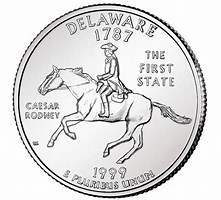
Caesar Rodney Quarter
Although each signer has a story, there are two that I like to tell. The first is about Caesar Rodney. Rodney was an American lawyer and politician from Delaware. He was an officer of the Delaware militia during the French and Indian War and the American Revolution and a Continental Congressman from Delaware. In July of 1775, the colonies were not able to agree on whether to separate from Britain. To break the deadlock, Rodney rode 70 miles through a thunderstorm on the night of July 1, 1776, arriving in Philadelphia “in his boots and spurs” on July 2, just as the voting was beginning. He broke the deadlock, thus securing the word “unanimous” in the document’s title. His efforts to ensure unity were one key reason for the colonists’ ability to secure their freedom. We commemorate Rodney’s ride on the 1999 Delaware quarter.
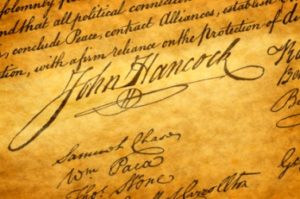
John Hancock
John Handcock is another interesting signer. Noted mostly for his large and distinguished signature on the Declaration, Handcock has been assigned the quote, “The British ministry can read that name without spectacles; let them double their reward.” However, few know why he was so angry. After the Boston Tea Party, the British blockaded Boston’s harbor. It was to teach the colonies a lesson. The only goods that could be imported required smugglers who were daring enough to run the British blockade.
“Liberty” was a sloop owned by John Hancock. The ship was being used to smuggle Madeira into the colonies. Madeira is a fortified wine made on the Portuguese Madeira Islands, off the coast of Africa. His ship was seized by customs officials in Boston in 1768 and re-commissioned into the Royal Navy as HMS Liberty. In the following year, the Liberty was burned by American colonists in Newport, Rhode Island, in one of the first acts of open defiance against the British crown. The idea that the King could seize private property thrust Hancock into his role as an activist.
The Revolution
The war itself lasted eight years. Because it was hard to keep track of statistics in 1776, the number of people who died can only be an estimate. For colonists, the estimate is 25,000 to 70,000. The better numbers are 6,800 dead in battle, 6,100 wounded, and 17,000 dead of disease. For Britain, 9,372 died in battle and 27,000 died of disease. War was not only dangerous, but the common soldier was underfunded, and living conditions were terrible. That is why I have chosen not to spend time discussing battles unless I am encamped on or near a battlefield. Then it is appropriate to discuss the local history as part of the story. Instead, I have found that presenting the life of a common soldier during those times is a more appropriate way to inform the students about the sacrifices made by our ancestors.
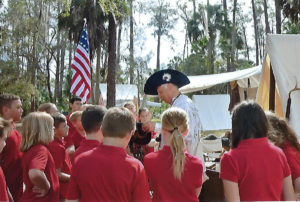
Sharing history with children
For that time, I dress in an appropriate set of clothing. From top to bottom, a tricorn or tricorn felt blank hat, an outer coat called a rifleman’s frock, a waistcoat (long vest), shirt, breeches, socks, and buckle shoes or boots. I have many outfits for specific presentations—those of an 18th-century minister, a common farm worker, a declaration signer, a minute man, and Ben Franklin. Students need to know that what a soldier wore would probably be the only clothes they would have for a year. While a common soldier might have a spare shirt or, if he was lucky, an extra pair of socks, our military was not well equipped. Regarding accouterments, I carry a flintlock rifle, a canteen, a haversack for incidentals, a knife, a compass, an axe or tomahawk, and most probably a cartridge pouch. Most military personnel would pre-roll paper cartridges with powder and balls to speed up the loading process during battle.
My presentation to the children includes discussions about what I am carrying. I empty my haversack and pass around things like an old compass, a spyglass, fire-starting flint and steel, a fishing kit (hooks are very different), and hard tack, which they can taste if they choose to. They see a two-pronged fork and wooden spoon, a pocket knife, my diary and portable quill with ink, soap made from lard and ash, dice for farkle, a powder horn, and a flintlock pistol or two. Add a cup, bowl, and plate, one small wool blanket, and you have a revolutionary soldier. They were usually cold or hot, wet when it rained or snowed, always hungry and tired, and they walked everywhere.
There are a few other interesting people that I try to mention during this time. Joseph Plumb Martin, the boy soldier; Debora Sampson, the first female soldier; James Caldwell, the fighting chaplain; Sybil Ludington, the teenage Paul Revere; and Betty Zane, the young hero of the last battle of the revolution. The list goes on and on. However, the people noted above have unique stories that children can relate to. Many were child soldiers. The ages noted at Valley Forge, for example, were 12 to 65. Time permitting, the story of Valley Forge is worth telling, especially through the eyes of Joseph Plumb Martin. His diary is the only surviving record of the American Revolution as seen through the eyes of an average person, a boy, a minister’s son, who remained with George Washington throughout the revolution.
A Diversion to Florida
Florida has a unique connection to the American Revolution. Since I live in Florida and do most of my living history events here, I especially love including Florida’s contributions. What you may find interesting is that there were at least three more colonies than the original 13, and these three chose to remain loyal to King George III. These were East Florida, West Florida, and Quebec (Canada). The East Florida colony had been under Spanish control since 1763 when France, Britain, and Spain signed the Treaty of Paris at the end of the French and Indian War. As part of the treaty, France gave up almost all its land in North America, and Spain gave up Florida. During the French and Indian War, Britain captured Havana, Spain’s busiest port. In exchange for Havana, the Spanish traded Florida to Britain. The British then divided Florida into two territories: East Florida and West Florida. This time was known in Florida as the British Period. With the Apalachicola River as the boundary, St. Augustine remained the capital of East Florida, while Pensacola became the capital of West Florida.
Established in 1738 by Colonial Spanish Florida’s Governor Manuel Montiano, Fort Mose’ gave sanctuary to Africans challenging enslavement in the English Colony of Carolina. Approximately 100 Africans lived at Fort Mose’, forming more than 20 households. Together, they created a frontier community that drew on a range of African backgrounds blended with Spanish, Native American, and English cultural traditions. This community served as a sanctuary for other slaves able to escape from the northern colonies. The site is just north of St. Augustine, FL.
East Florida had good, fertile soil and was excellent for farming. To bring settlers to East Florida, the British offered land grants to settlers who would come to farm and defend the new British territory. The first governor of East Florida was James Grant. Grant did more to increase the population of East Florida than anyone else. He remained friends with the local Indians and traded goods with them. Grant also encouraged settlers from North and South Carolina, Georgia, and other British colonies to come and start plantations, or large farms. Any escaping slaves from the northern colonies were given respite in Fort Mose’ where they could work and grow indigo.

Thomas Brown
The Florida storyline begins with a man named Thomas Brown. Born in Whitby, Yorkshire, England, Brown was of a prosperous family, with his father Jonas owning a successful shipping company. In 1774 Thomas recruited colonists from Whitby and the Orkney Islands and emigrated with them to the Province of Georgia. He established the community of Brownsborough northeast of present-day Augusta and anticipated life as a gentleman planter.
Instead of enjoying his new adventure, he became embroiled in the coming revolution. On August 2, 1775, a crowd of Sons of Liberty confronted him at his house. Brown requested the Liberty team leave him to his own opinions and finally met their demands with a pistol and sword. Brown was taken prisoner after being struck with the buttstock of a rifle, fracturing his skull. He was tied to a tree, where he was roasted by fire, scalped, tarred, and feathered. Thomas Brown survived, but this mistreatment resulted in the loss of two toes, lifelong pain, and headaches, and a matching hatred of the patriot cause.
This divisiveness from his neighbors and hostile acts so enraged Brown that he assumed the leadership of backcountry Georgia loyalists and developed a plan to support the Augusta area of the Tories with Indian allies from the west and a landing of British soldiers from the east. Thomas Brown would help put into effect a plan. Brown lived with the Creeks in 1776 and 1777. After gaining their confidence, he established a network spreading from Florida to the Carolinas. In 1779, he was appointed Superintendent of Creek and Cherokee Indians and continued his efforts to engage the Patriot cause in the conflict.
Brown also came to lead a mounted Loyalist company eventually styled as the King’s Rangers (locally known as the “East Florida Rangers”). He developed this group of men, consisting of British loyalists, Indians, and blacks, into a uniformed and disciplined unit and became a skilled commander himself with the rank of provincial Lieutenant Colonel. Thomas Brown may have single-handedly added several years to the length of the revolution itself.
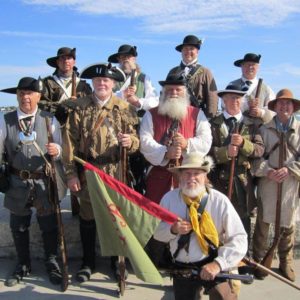
Today’s East Florida Rangers
John Hewitt, an expert builder and contractor, arrived in St. Augustine before the American Revolution in 1768. He obtained a 1,000-acre property near Pellicer Creek in what is now Flagler County and shortly thereafter built a sophisticated water-powered sawmill. During this period of American history, the hostilities by the patriots against the loyalists would force a migration to St. Augustine of over 25,000 people. St. Augustine would become a melting pot of Spanish, British, Indian, and black people. So heavy was the migration of people that Hewett’s Sawmill would produce thousands of board feet of lumber daily to build a city. It would be this town, St. Augustine, that Thomas Brown’s troops, the East Florida Rangers, would protect. While several attempts from patriot troops were made to invade the capital city of St. Augustine, the East Florida Rangers, with about 400 men, would successfully defend the city until the British left after the end of the American Revolution.
This story does not end here. Once Florida became part of the United States, there was no sanctuary for the Indians, escaped slaves, remaining British settlers, and even a few Spanish holdovers living in St. Augustine. Many went south to the Caribbean Islands; some returned to England. Those who remained went inland into the harsh interior of Florida. This composite of cultures would become known as “the Seminoles.” The word “Seminole” is derived from the Muscogee word simanó-li, which may itself be derived from the Spanish word cimarrón, meaning “runaway” or “wild one.”. Peace would not last long. Led primarily by Andrew Jackson, there would be over 40 years of war in Florida. The Seminole Wars (1817–18, 1835–42, and 1855–58) were three conflicts between the United States and the Seminole Indians of Florida in the period before the American Civil War that ultimately resulted in the opening of the Seminole’s desirable land for exploitation and settlement. I tell this story because our children should understand that people can work together toward common goals but never repeat the hatred displayed in this history.
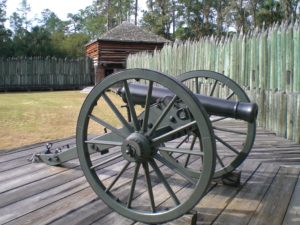
Fort Foster
During this time, hundreds of forts were built in Florida, usually one day’s ride on horseback from each other. The only safe way to travel was to ride by day and stay in a fort at night. One such fort near me is Fort Foster. Fort Foster was originally built in December 1836 under the direction of Lieutenant Colonel William S. Foster on the site of Fort Alabama. During its history, it was rebuilt several times. Fort Foster protected a key bridge on the Hillsborough River. Now owned by the State of Florida and managed by the Department of Environmental Protection, this fort has been restored to its original character. Living history events are frequently held there. I have attended many with up to 1,000 schoolchildren coming to “live history.”
In 1830, a series of forced relocations began of approximately 60,000 Native Americans in the United States from their ancestral homelands in the Southeastern United States to areas to the west of the Mississippi River that had been designated as Indian Territory. The forced relocations were carried out by government authorities following the passage of the Indian Removal Act in 1830. The relocated people suffered from exposure, disease, and starvation while en route to their new designated reserve. Approximately 4,000 died before reaching their destinations or shortly thereafter. The forced removals included members of the Cherokee, Muscogee (Creek), Seminole, Chickasaw, and Choctaw nations, as well as their African slaves. Few Floridians know that the “Trail of Tears” had its roots in Florida.
The Constitution
While the Constitution of the United States is the bedrock of our freedoms, the task of explaining it to children is my most difficult task. Aside from presenting a life-size replica and taking them through the basic three parts of our government, I spend most of my time setting them up for a discussion on personal rights. To do this, I use a game. This works best with a large group:
All adults and mentors in the Patriot Camp have permission to give out a piece of hard candy for each good, creative question. Children are told you can eat the candy or save it. If you save it, you can turn it in for prizes at the end of camp. We have good prizes. Prizes are priced based on “pieces of candy.” Those who have saved more, can buy more prizes. As the camp progresses, most children store their rewards in a small bag and bring it with them every day. The last day is saved for our discussion on Ben Franklin and what is a Constitutional Republic. We take them back to the times of the Magna Carta and The Great Law of Peace, the building blocks of freedom. And then comes the question: Who has the most candy? There is always one child that is the winner. Once that child is identified, I ask the next question–Who would like some of their candy?
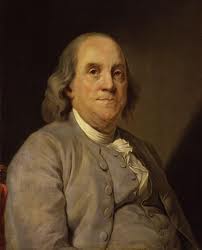
Ben Franklin
I am never disappointed. Every hand, including those of the adult leaders, goes up except for our winner. At this moment, I say that we all have just experienced a “true democracy” where the will of the majority can vote away the rights of the minority. America is not a democracy. Franklin was walking out of Independence Hall after the Constitutional Convention in 1787 when someone shouted out, “Doctor, what have we got? A republic or a monarchy?” To which Franklin supposedly responded with a loud, “A republic, if you can keep it.” What, then, is a republic? I asked the children what kind of society we would have if I took everyone’s candy and then shared it back equally. Of course, before sharing, the adult leaders got to take whatever they wanted first. The answer is socialism. A republic is quite different. First, it establishes a set of shared authorities and shared responsibilities that are limited by certain rights of the citizens. Unlike a monarchy with a king, the United States balances all powers against the rights of its citizens first. A republic is what gives the child with the most candy the right to keep it because they earned it. Children must be taught that it is worth keeping!
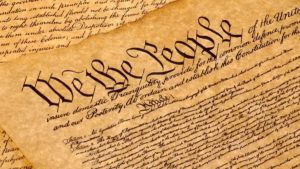
The Constitution of the United States
Children need to know that we have three branches of government. What controls these three branches and their ability to affect your rights remains in the hands of all citizens. It is called the right to vote in “fair and free elections.” No matter what the age of the children is, it is beneficial to reinforce that it is the citizens who choose their government and to neglect that right is to abrogate your freedoms. It is also worth discussing that there are powers that have been divided between the Federal Government and the states. However, there is no circumstance under which a state or a part of the Federal Government can take away a fundamental human right guaranteed to us. That is the balance of powers between our executive branch, Congress, and courts. Together, this three-legged milk stool upholds the greatest country ever created, the United States of America.
If the children are old enough, I like to include a discussion about the “Federal Register.” The Federal Register is a government publication that provides public notice of new regulations from the Office of Thrift Supervision, legal notices, presidential proclamations, executive orders, documents required by an Act of Congress, and other official documents of public interest. The Federal Register is published daily, Monday through Friday. The 1936 Federal Register was 2,620 pages long. It has grown steadily since then, with the average annual page count varying between 80,000 and even higher. It contains the “rules” that our elected officials and non-elected officials make up that we must follow. There is a problem here that is worth addressing! Here, I would like to at least introduce the word “bureaucracy” into their vocabulary. As adults, they will get to know it all too well.
Discussing the Bill of Rights
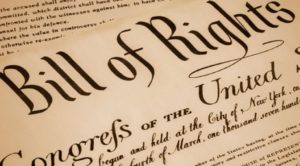
Bill of Rights
Now for the last day’s discussions and wrap-up. In comes a life-size copy of the Bill of Rights. A constitutional republic allows for the retention of certain inalienable rights. Our winner gets to keep their candy because they earned it. We get to keep our freedoms because we have a Constitutional Republic that guarantees them. To conclude the day, one by one, each of the first 10 amendments will be discussed. Not just as numbers, but what they mean and why it is important to them as both children and future adults. It is often worthwhile to even take them back to the events in history that led up to the necessity of having the amendments we do have today. Let us look at just one example: the prohibition of “quartering.”
Most people remember that the 1st Amendment gives us our rights to free speech, peaceful assembly, and religion. The 2nd Amendment assures our rights to personal defense. Few know that the 3rd Amendment assures that your home cannot be seized by the government. Quartering was the act of providing housing for military personnel, especially when imposed upon the home of a private citizen without permission or fair compensation. This issue can be traced to the Great Law of Peace, where the Hiawatha Wampum prohibited the seizure of another person’s lodge. King George III’s troops so abused their power that our forefathers felt strong enough to make this the 3rd personal right within our Republic. Why is it important? Does our current government still abuse its power? A short and quick discussion on eminent domains and environmental activism can quickly show that the 3rd Amendment is still as important today as it was in George Washington’s time.
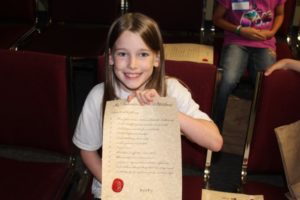
A Patriot Camper with her signed Declaration
To close my camps, I use a “Children’s Declaration” to tie things together. My Declaration is printed on parchment, contains a wax seal, and holds 12 simple points that we first discuss. Children can make a difference in our country, and it is worthwhile to let them know what is expected of even our children in America. I ask the children to think about and then sign their own declaration.
- To my fellow campers, teachers, and parents, I will be honest
- I will be respectful of people, property, and my country
- I will always remain hopeful
- I will be thrifty and not wasteful
- I will do all things with humility
- I will be generous and charitable
- I will be sincere
- Moderation will affect how I choose to live
- Others can depend on me to work hard
- I will have courage and be brave, trusting in God’s plan
- I will not blame others for things that I can change myself
- I will be thankful for my friends, family, country, and God
To be signed with quill and ink by each child.
Conclusion
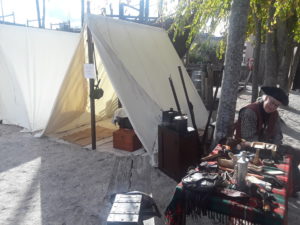
My typical camp at a living history event – And yes, I do spend nights i that tent, cooking on a small brazier.
It has been an honor over the many years to be able to share my passion and love of history with so many children and adults. Many of my events have been within the backdrop of historic places like the Castillo de San Marcos in St. Augustine or Fort Foster. There I would live in a military wedge tent and offer visitors a broader look at history. Not only good for them to see how our ancestors lived but good for me to enjoy the time immersed in our nation’s history. Time I will always relish. It was wet in the rain, and cold in the winter. My meals were cooked on a simple brassier. The children I have gotten to know are grown now as are two grandsons who participated in many of my events. Like me, their lives are better for the experiences. However, our Republic always remains only one generation away from extinction. With every passing generation, it becomes more paramount to share history, to learn from what we have done wrong but build upon what our ancestors have done correctly. I hope to see you at a living history event one day. Make sure you say hello!
Bob Samson
A link to Patriot Camp materials
